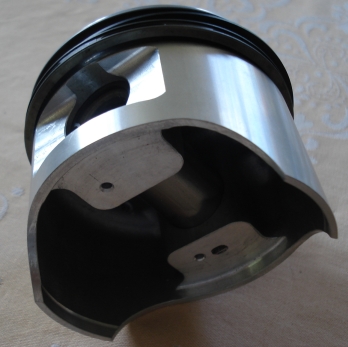

 |
 |
I wrote a book about this.
News

History:-
The standard Vanguard 6 engine from 1960 was originally 1998cc & gave 75-85 Bhp with tiny Solex
carburettors or 150CD Strombergs.
It was designed to replace the aged 200+kg MF tractor engine used in the other Vanguards & TR3 sports cars,
weighing 20kg less & being very compact
A very rare car now as under 10 000 were made it was superseded by the Triumph 2000 soon after.
The crankshaft was stroked in 1967 to 95mm and the block altered to give 142 Bhp on the TR5.
Some innovative features, notably MACHINED chambers made the head a "sleeper" in the engine tuning stakes until 1982
Some 2 years after Triumph closed up:-
I designed & made a new type of exhaust manifold which capitalised on the excellent breathing potential.
I wanted to improve my own car which by then was some 12years old.
All the solutions such as SAH accessories were either poor quality or simply didn't work as claimed.
It gave an enormous power gain of +33bhp on an otherwise STD TR5/early TR6 engine
with just a little adjustment to fuelling. (175Bhp DIN).
This was an interesting project, because the engine had good potential,
which had clearly never been realised before.
(and mostly because of the excellent but antiquated synchronous mechanical
Lucas injection).
It turned the pleasant but rather limited Triumph TR6 straight six from
a noisy thirsty 60s British sportscar into a true 130mph+ rocket.
Merely fitting the exhaust and a few modifications to the timing and
injection lopped nearly 2 seconds off the 0-60 time, produced a wopping
180Ftlb torque at 2500rpm and remaining substantially FLAT (linear) to over
4500rpm.
Following some clear demonstrations, the exhaust design then became the DEFACTO standard for all Triumph 6 cylinder engines for ever after.
This road car work giving far better fuel efficiency was then used to make a true race engine from the original short stroke design.
The "Vitesse"/GT6 pi & Evo units
This was the same as the Mk11 2.5L Engine & Lucas Pi, but using instead the 2000cc crank/pistons. (98Bhp
DIN original)
A power gain over the original carburetted engine hit 40+Bhp DIN, but allowed an extra 1000rpm without risk.
(with a road camshaft change +57Bhp DIN).
As dev proceeded, Race engine powers became more & more promising with an increase over the original unit of up to +138Bhp.
Why & How?
A short stroke lightweight crankshaft allowing far less torsional problems.
Standard-Triumph engines were designed and optimised for a stroke of 76mm,
so this engine is identical to the Spitfire 1300 with 2 extra cylinders.
More compact chamber, lighter crankshaft & shorter push rods.
A block allowing substantial overboring + weight falling to less than 160kg.
Lucas injection & the excellent inlet manifolds made for Triumph cars.
This meant it was possible to run proper race camshafts -long duration,
high compression ratios all the stuff needed to get
engine speeds of nearly 9000 rpm, with good useable power to 8500rpm.
Making a low volume race engine:-
Race engines differ from road engines in using lightweight high strength components.
This one became a classic and a few detuned ones ended up in road cars;-
Some items used;-
Steel flywheels made to measure.
Steel and titanium alloy con rods
High grade lightweight steel cranks with a unique design.
High grade valves which have ALL been tested and optimised for flow.
High grade pistons from RR59 blanks made to measure.
Optimisation and changes to the fuel injection system.
Items optimised to make the basic design better & better,-
eg,slight lengthening of rods,
lighter pins, changes to ring sizes and materials, slight lengthening of stroke, dry sump, proper race exhaust etc
As dev proceeded, bore was and capacity was taken to 2.2L, then 2.3L then 2.5L.
A slightly longer stroke was found to be absolutely ideal, as the engine ceases to work well above 85mm stroke.
We aimed for and got,-
High torque output (200ftLb+) between 4500-6500rpm resulted then in rapid crankshaft acceleration (+steel flywheel)
The engine peaked at 7900rpm had excellent torque characteristics from 4500rpm to 7000rpm and a very wide power band.
Problems always remained,- the poor breathing of the badly shaped
exhaust port, and difficulties with cooling after such a large power increase,
+ variations in power output when fuel pressure dropped below 130psi.
These are all resolvable.
We were lucky to have access to the original Spitfire Le mans 1147 camshafts
at an early stage, and a number of uncut blanks.
Our collaboration with Holbay (now ceased trading) enabled us to get
extraordinary results from the engine which has only 4 main bearings, and
a strong rigid block.
We now make our own forged pistons, with our own press tools, in a purpose made facility.

press Here for applications currently supported
The results speak for themselves,-
Don't believe anyone when they tell you xxx or yyy designed our 6-3-1 or piston designs.
it's just a rip off of proper design work then remade badly!
Tuning Kits | Links | Specialist Facilities | Triumph modified Cylinder Heads | Latest innovations | Fuel injection